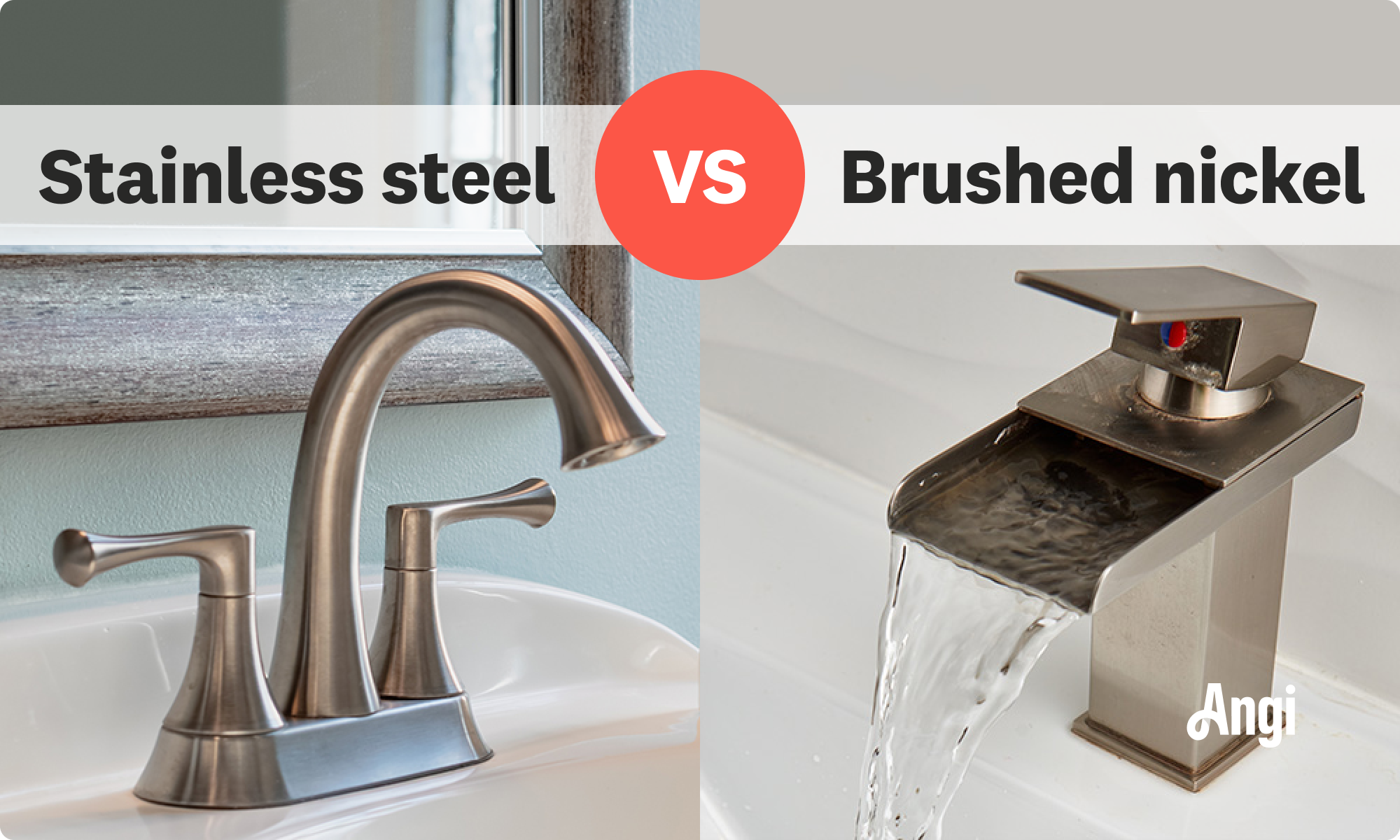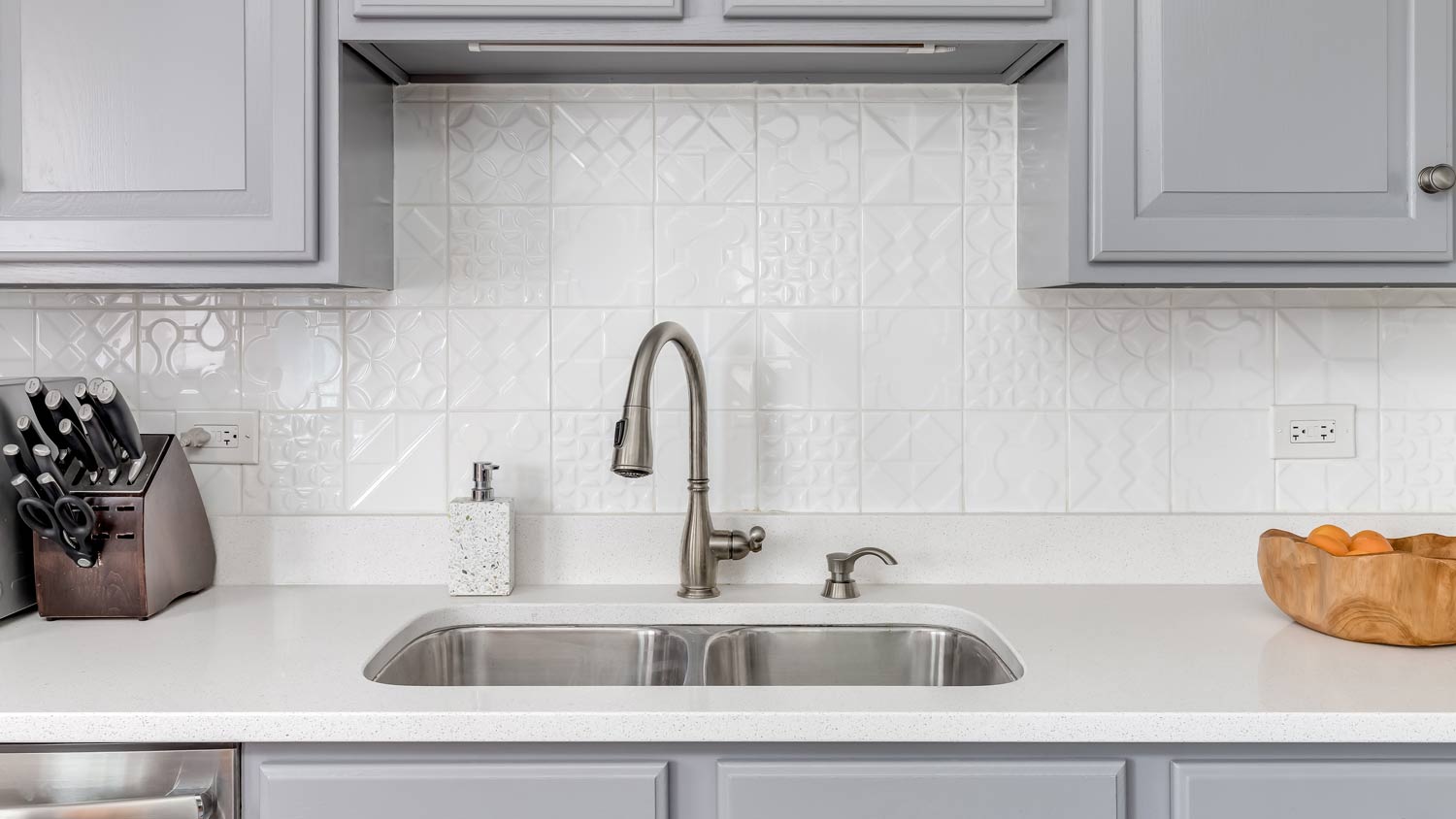Brushed Nickel vs. Stainless Steel Faucets: Which Is Best for You?
Choose from some of the most popular faucet materials


Brushed nickel faucets have a versatile and subtle look that fits a variety of aesthetics.
Stainless steel faucets are more eye-catching and have a shiner appearance.
Brushed nickel hides minor imperfections and resists rust.
Stainless steel is lead-free and very durable against daily wear and tear.
When you've narrowed your faucet options to a few possibilities, it's time to dive into the details of each material so you can make the best choice for your remodel. When it comes to brushed nickel versus stainless steel faucets, you'll see that the two materials differ in their appearance, maintenance needs, and more. Depending on your vision and the aesthetic you're looking for, one will work better than the other. Here’s how these two materials compare in multiple categories.
Brushed Nickel Faucet vs. Stainless Steel Faucet: Key Differences
The main difference between these two faucet materials is that brushed nickel is nickel-plated, while stainless steel faucets are either solid or plated. The two materials offer different advantages, with brushed nickel being rust-resistant while stainless steel is more hygienic. Brushed nickel is also more suited for traditional spaces, whereas stainless steel faucets fit contemporary ones.

Brushed Nickel Faucets

Brushed nickel faucets offer a subtly elegant look without stealing the show. These faucets have a zinc base with nickel plating that the manufacturer treats to create the “brushed” semi-satin finish. They have a yellowish-gold tone compared to the cooler colors of stainless steel.
| Pros | Cons |
|---|---|
| Versatile look that fits with many different aesthetics | Plating can wear down |
| Rust-resistant | No universal finish |
| Hides small imperfections | Blends in with many decor styles |
Best for:
Traditional-style homes
High-traffic kitchens and bathrooms
Spaces with wow factors that don’t require an eye-catching faucet
Pros of Brushed Nickel Faucets
One of the most significant pros of brushed nickel faucets is their versatility. This material can be used in many different bathroom or kitchen styles and meshes well with varying types of materials. For example, you can use brushed nickel faucets in a traditional-styled kitchen with wood cabinets, bringing out the material's warm undertone. Or, you could mix different metals like a brushed nickel with brass or chrome in a modern-styled space.
There are practical advantages to brushed nickel, too. It’s rust-resistant, so you don’t have to worry about corrosion, which is a huge plus in an area with hard water. And it doesn’t easily show fingerprints and water spots, so you don’t have to work overtime to keep it clean.
Switching out the hardware can make a bathroom vanity look new. When choosing knobs and pulls, don’t forget to choose colors and finishes that complement your new fixtures. Nickel and black are universal choices, or go with a slightly different finish in a unique shape.
Cons of Brushed Nickel Faucets
This metal doesn’t stand out in the room. So, while stainless steel can pop with its shiny silver hue, your nickel faucets will blend into the background. This isn’t necessarily a con, but if your space lacks focal points, you might consider a different material to help tie everything together.
The nickel plating can wear down over time, especially if you use harsh cleaners or you’re nearing the end of your faucet’s life span. Once the plating wears down, your best bet is to purchase a replacement. A faucet installer can recommend a long-lasting material for your bathroom and install your new faucet.
Also, there’s no universal brushed nickel finish, so there will be slight variations between manufacturers. Choosing a fixture in person whenever possible is best to get the exact tone you want. If you use additional brushed nickel fixtures beside your faucet, buying them all from the same manufacturer means you’ll have an exact match.
Stainless Steel Faucet

Stainless steel faucets, solid or plated, offer a modern touch to kitchens and bathrooms. They have a high-gloss shine and can tie together minimalist or contemporary spaces. You can pair stainless steel faucets with matching stainless steel sinks or go for a contrasting look with a darker stone sink, like granite.
| Pros | Cons |
|---|---|
| Durable | Shows water spots |
| 100% lead free | Susceptible to scratches |
| Easy to clean | Doesn’t go with every decor style |
Best for:
Modern homes
Someone looking for a low-maintenance faucet
Outdoor kitchens
Pros of Stainless Steel Faucets
A notable advantage of stainless steel faucets is their durability. You’ll see stainless steel in commercial spaces like restaurants because it can withstand the heavy wear and tear of daily use. In particular, Grade 316 stainless steel faucets are resistant to hard water, moisture, and sun exposure, so you can install them in outdoor kitchens. In addition to its durability, this material is hygienic because the smooth surface is easy to clean. If you like to maintain a high level of cleanliness in your home, this could be your material of choice.
Stainless steel also has another advantage for anyone who is particularly health-conscious. It’s lead-free, while some other faucets contain low levels of lead. For example, until 2014, some faucets had brass valves that could contain up to 8% of lead. After 2014, the acceptable lead levels dropped to 0.25%. Some manufacturers guarantee a 100% lead-free faucet regardless of the material, but stainless steel is an easy choice if you don’t want to do much research before buying a faucet.
Cons of Stainless Steel Faucets
When considering the pros and cons of faucet finishes, think about their daily maintenance needs. Although stainless steel faucets have many advantages, they require more daily upkeep than brushed nickel. Depending on your cleaning schedule, that could pose an inconvenience. The shiny, smooth surface is easier to wipe down, but water spots and fingerprints stand out. Using the right cleaners and materials is necessary because using abrasive cleaners can lead to unsightly scratches.
Carefully consider the rest of your kitchen fixtures and appliances before going with stainless steel faucets. For example, some homeowners don’t like the look of stainless steel faucets in a kitchen with all stainless steel appliances because it’s too much of the same color.
To avoid this, you can mix metals. It comes down to personal preferences, but some metal types and finishes can clash with stainless steel, like gold and copper, which are warmer in tone. It’s best to stick to two to three metal types at most and avoid overusing similar textures and colors.
Moreover, stainless steel's shiny silver tone looks better in modern, contemporary spaces than in traditional- or farmhouse-style homes.
Brushed Nickel Faucets vs. Stainless Steel Faucets
If you’re having difficulty choosing between brushed nickel and stainless steel faucets, comparing cost, maintenance, and durability to help you narrow it down.
Cost: Stainless Steel Faucets
Brushed nickel faucets can cost more, ranging between $100 and $1,100. Stainless steel faucets, in comparison, run $100 to $600. As long as you’re flexible about the faucet you want, you can find one that fits your budget in either material.
Note that the total cost of replacing a bathroom faucet includes the materials plus labor, which is $175 to $360. Although handy DIYers can do the installation and save on labor costs, it’s best to hand the job off to a pro. When you’ve decided which faucet you want, a faucet installer near you can get it working in your bathroom or kitchen.
Maintenance: Tie
The daily wear and tear on your faucets isn’t as obvious on brushed nickel since the finish hides small imperfections. Keeping them clean is straightforward as most marks, including hard water and grease spots, are easily wiped away with warm water, dishwasher detergent, and a microfiber cloth.
On the other hand, the shiny finish of stainless steel is less forgiving. Fingerprints and watermarks show up much easier on these faucets. Implement a regular cleaning schedule to keep them looking shiny and new. The best method to clean it is with a mixture of 1 part vinegar to 10 parts water and a microfiber cloth.
Although you have to work a little harder to keep your stainless steel faucets clean, they’re easier to wipe down because of their smooth surface, a major plus for anyone looking to keep a tidy home.
Durability: Stainless Steel Faucets
While both brushed nickel and stainless steel faucets are durable, the latter is a little more hardy. That’s why you see it in commercial settings like restaurants and hospitals. In particular, solid stainless steel faucets (rather than stainless steel-plated) will outlast the wear and tear of high-traffic bathrooms and kitchens.
Design Options: Brushed Nickel Faucets
Brushed nickel and stainless steel faucets are trendy, so you’ll have many design options with either type. But when designing your space, you’ll have more flexibility with brushed nickel fixtures than stainless steel. This is because brushed nickel mixes and matches well with a wide range of materials, including natural stone and wood.
However, designing with stainless steel can require more thought. For example, some homeowners don’t like the look of stainless steel fixtures with matching appliances because it’s too much of the same shiny color. And when you use stainless steel with wood, it creates an industrial vibe that you may not want.





- Bathroom Remodeling
- Kitchen Remodeling
- Shower Installation
- Stair Installers
- Bathtub Installation
- Shower Door Installers
- Kitchen Design
- Bathroom Design Companies
- Storm Shelter Builders
- Pre-Made Cabinets
- Kitchen Refacing
- Bathtub Replacement
- Ceiling Tile Installation
- Suspended Ceiling Companies
- Residential Designers
- Stair Builders
- Remodel Designers
- Shower Enclosures
- Home Renovations
- Kitchen Renovations
- Garage Remodeling
- Grab Bar Installation
- Walk-In Tub Installers
- Tub to Shower Conversion
- Balcony Contractors
- What’s the Difference Between Brushed Nickel and Chrome?
- Chrome vs. Stainless Steel Faucets: Which Is Better?
- How to Clean Stainless Steel Appliances and Make Them Sparkle
- How to Paint Stainless Steel and Make It Stick
- White Appliances vs. Stainless Steel Appliances: A Complete Comparison
- Black Stainless Steel Sink Pros and Cons: What to Know Before You Buy
- How To Remove Rust From Stainless Steel: Transform Your Appliances and Cookware
- How to Remove Scratches From Stainless Steel Appliances in Under 25 Minutes
- What’s the Difference Between a Composite Sink vs. Stainless Steel Sink?
- What Is a Smart Kitchen Faucet and How Does It Work?











